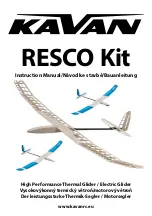
5.2.13 Landing Distance
NOTES:
- When landing on a dry, grass runway, increase the required landing distances by 15%.
in 50 ft
Touchdown
- Increase ground roll appropriately for wet grass/ground, ice, snow and slush.
65
45
- An improperly maintained aircraft, deviating from procedures,
65
43
poor meteorological and ambient conditions (rain, crosswind,
wind shear etc.) may increase landing distances significantly.
Conditions:
Power setting: Idle
Propeller: Take-off (propeller control lever: HIGH-RPM position)
Flaps: LDG
Maximum brake application.
Paved, level and dry runway.
Example:
Pressure altitude: 380 ft
Landing mass: 1453 lbs (659 kg)
Headwind component: 9 kts
Landing distance: 1230 ft (375 m)
Outside air temperature: 68°F (20°C)
Ground roll: 525 ft (160 m)
POH / AFM
AQUILA AT01-100C
Section 5
PERFORMANCE
Page:
Issue:
Airspeed [KIAS]
Ldg Weight
[lbs]([kg])
1653 (750)
1323 (600)
5 - 15
FM-AT01-1010-103
A.02
Supersedes Issue:
28.05.2013
Date:
15.10.2013
Document Nr.:
MSL
2000 ft
4000 ft
-30
-20
-10
0
10
20
30
40
Outside Air Temperature
Pressure
Head
550
575
600
625
650
675
700
725
750
Landing mass
0
2
4
6
8
10 12 14 16 18 20
Wind Component [kts]
Headwind
Tailwind
0
100
200
300
400
500
600
700
800
900
1000
0
50
Landi
ng
D
is
ta
nce
[
m
]
Ground
R
ol
l
[m
]
Obstacle Height [ft]
[f
t]
Do not use
intermediate
values!
°F
-22 -4 14 32 50 68 86 104
°C
kg
lb
1650 1540 1430 1320 1210
[f
t]
3280
2952
2624
2296
1968
1640
1312
984
656
328
0
A









































